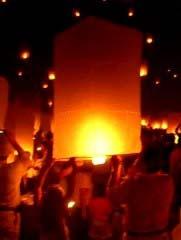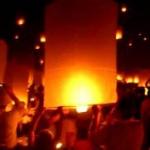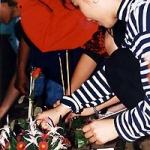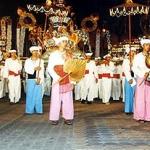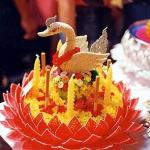The Loi Krathong Festival in Chiang Mai, Thailand
Here in North Thailand the Loi Krathong Festival is much different than anywhere in the Kingdom. In the small town of Mae Jo north of Chiang Mai they started the festival on Saturday night by launching hot air balloons called "Khom Loy".
This festival is held on the night of the 12th full moon of the year in most of the countries where it is celebrated, except in Laos, where it coincides with the 11th full moon at the end of the rains retreat, the Buddhist Lent. In many of the Thai provinces facing Laos across the Mekong River, there may also be a major festival of floating lights at that time, such as Nakhon Phanom's spectacular Lai Rua Fai (many illuminated boats). Loy Krathong may have originally been timed to coincide with the end of the life-giving rains, as a kind of harvest festival giving thanks for the abundance of the crop now filling the granaries and wishing for further bounty in the year to come. There is also a great deal of symbolism involved in the floating away of the Krathong, representing a cleansing of sins.
Loy Krathong has an unequalled charm and mystique, whether it is celebrated on a grand scale in a major city or quietly in a small village of just a few rude huts, but for a truly breathtaking experience, the north of Thailand is the place to go. Even from the end of Lent, the build-up starts with firecrackers banging and booming in the night and, gradually, there appear what seem to be moving orange stars in the sky. As Loy Krathong itself nears, coconut frond archways spring up at the gates of houses, earthen lamps glow in the night, and paper streamers and lanterns appear everywhere.
With the rainy season gone, the night sky is clear and coolness fills the air. On the night of Loy Krathong itself, the full moon sails over the horizon into a sky filled with light and sound, for the Lanna folk celebrate Loy Krathong in three dimensions. Giant hot air balloons, called Kome Loy, rise into the sky, their fires visible, like some galaxy of orange stars, into the far distance. Traditional rockets known as Bok Fai outdo the myriad of other fireworks crackling and popping everywhere in the crisp night air. And beneath this frenzy of noise and light, the gentle, quiet, and touching act of floating (loy) one's Krathong.
The traditional months of Lanna are different from the rest in Thailand, and Loy Krathong is always celebrated in Duan Yee - the second month - and the period of the festival is called Yee Peng. It is an important time with Krathong and a different Buddhist ceremony, called Tang Tham Luang, falling within this month. The decorations around houses and temples come alive during Yee Peng with the Kome paper lanterns glowing a host of bright colours. Walls surrounding compounds are decorated with the earthen lamps called Phang Patit. The number of these lamps must correspond with the total age of all family members combined, and their flickering yellow flames give warmth to the cool evening.
The Krathong are traditionally made from cut sections of bamboo, with neatly folded pieces of banana leaf around the edge, giving the appearance of a lotus leaf. Each must be decorated with a candle, an incense stick, and some flowers, though many are more elaborate. Often some grains of sand and good luck charms are placed on the Krathong, and a few coins are often added; though these usually end up as some young boy's extra pocket money. At home in the water, they swim from Krathong to Krathong and a little brown hand gropes around for what it may contain. These days the convenience and buoyancy of Styrofoam have largely and, unfortunately, replaced traditional materials, as they litter bank and shoreline for weeks after the event. This year, 2007, the Loy Krathong festival is from November 24 to 26. In Chiangmai, there are raft races on the river on the first day, and boat races for the next two days. The Yee Peng opening ceremony takes place at Tha Pae Gate early on the first evening, followed by a lantern parade and contest at the Night Bazaar. Beauty contests will be held at Tha Pae Gate on the second and last evenings, and parades of individual Krathongs and giant Krathongs start from there on the second and third evenings. Every night, there will be fireworks, Kome Loy launchings, Lanna cultural performances at the Municipal Offices near the river, and, of course, there is nowhere better to loy your own Krathong.
Tradition has it that the very first Krathong was made by a beautiful young lady at the royal court of the ancient Kingdom of Sukhothai some 700 years ago. Her name was Naang Noppamart, and she was blessed with great artistic skills. Others imitated her and there was a competition on the night of the 11th full moon of the year. The king judged the competition. Naang Noppamart's talents were repaid as her Krathong was declared the clear winner. The king decreed that henceforth this one night of the year should become a festival of thanks and should be celebrated by the floating of boats in the shape and form of lotus leaves. The legend lives on and the beauty queen selected at each of the Loy Krathong celebrations around Thailand is, to this day, the winner of the Naang Noppamart parade.
Dating back to ancient days, the decorative ceremony of lanterns was based on Brahmin beliefs, or Brahmanism. At this ceremony, the people of long ago paid respect by worshipping three different gods. These gods were Pra I-Suan, Pra Narai, and Pra Prom. For this reverent ceremony, the candles used to light up the lantern were made from cow's fat or a wax that came from within the royal gates of the reigning monarch. Usually these candles were made by a Brahmin priest, and of course, the process of making the candles strictly followed the requirements of a Brahmin ceremony.
Formerly, lantern decorations were commonly seen hanging on all mansions in the grand palace. The great numbers and the beauty of the lanterns reflected the status of the royal family members. (Next to the king, the titles of royalty were Jow Fah, Pra Ong Jow, Mom Jow, Mom Rajawong, and Mom Luang). There were also three classifications of lanterns, which were the Kome Chai, the Kome Pra-Tiab, and the Kome Boriwan.
Up until the present time, a tradition developed wherein people sacrifice their time to design and assemble various kinds of strong, beautiful, and creative lanterns. The worshippers donated the lanterns to the temples, asking their wishes to be fulfilled. Usually the person would say a prayer requesting his desire to be a sharp, brighter, and more clever person in the future. This belief is based on the comparison that a bright light would lead a person out of his present darkness into a lustrous future.
As mentioned earlier, these lanterns were devoted to the three different gods. The lanterns were also presented to high ranking officials and wealthy people. It is then interesting to understand why Komes were so presentable and how these lanterns are made. The main structure of these lanterns are usually made with bamboo and covered with a coarse palm paper or cloth. Inside, a bamboo cylinder was necessary to protect the possible burning of the paper, since, altogether, 24 candles were required to light up the lantern. This large number of candles made illumination possible for about three hours. Candles were not always used to light these lanterns. Oils, such as sesame seed, castor, or coconut oils, were also used. The creation of these lanterns is open for the public to see and study at Chiang Inn Plaza during this festival.
People thought that lanterns could only be lit during Buddhist holidays or ceremonies, but, actually, lanterns can be lit every evening or night. These lanterns can be hung on gates, fences, doors, windows, or the roof, or any place an individual wants to adorn with these delightful creations.
There have been four different purposes for the northern Thais to hang lanterns. They are for beauty, to pay respect to Buddha images, to make one's home or mansion brighter, and for propitious purposes.
Nowadays, there are four traditional Komes in the north that attract visitors every year. They are 1) Kome Thuea (carrying lantern) or Kome Gratai (a rabbit's ear), 2) Kome Kwaen (hanging lantern), 3) Kome Paad (revolving lantern), and 4) Kome Loy (hot air floating lantern).
A Kome Thuea or Kome Gratai has a lighted candle inside. A Buddhist believer will carry it along during the Yee Peng Parade. When the parade is over, the worshippers will take the lanterns and decorate the temples, vihara, and other buildings. If there are other celebrations other than the Yee Peng Festival, beautifully made lanterns are used to decorate a stage. Usually, a lantern shaped as a lotus is used to pay respect and the citizens will pray to the Buddha images and make offerings to the monks.
Kome Kwaen are also offered to pay respect, and prayers to Buddha images are made. There are several shapes of this certain lantern. They are the Baat Pra (Alms bowl), Dow (Star), Ta Gra (Basket), and Tammajak (the wheel of law, which means to have a thorough knowledge about religious discourses). The Buddhists will hang these lanterns around a temple, vihara, alms-house, sala, or house.
The Kome Paad is an interesting lantern since it revolves on an axis. This is done with the aide of the heat from the candle's smoke. In order to make it revolve, the candle is placed inside the lantern where little gadgets take the energy from the smoke and then revolves. The lantern is shaped like a circle, almost like the earth. Usually there are pictures glued on, such as the 12 characters of the horoscope. This revolving lantern will give the effect of shadow puppets. Kome Paad can only be seen during the Yee Peng Festival. It is placed in the temple gates and is not allowed to be moved from one place to another.
The Kome Loy is a lantern that is similar to a hot-air-balloon. It is also quite similar to that of a normal lantern except it does not require 24 candles for illumination. Because the air lantern must rise up to float in the air, it must be lightweight; therefore, it does not have a bamboo cylinder inside. In order to send the lantern into the air, it requires a method to heat the air. This is done by tying a small bowl underneath the open section of the lantern. Oil is then placed into the bowl along with a cotton cloth. As the oil catches fire and commences burning, the hot air quickly travels into the lantern and it soon rises into the air. To see a video of thousands of Kome Loy being launched at the same time see http://www.all-thailand-exp.com/images/LK.wmv
It is believed that by sending off these lanterns an individual can send one's sins and bad luck into the air. Usually before the lantern soars into the sky, an individual will pray that one's sin or bad luck will be transported on the lantern and floated away high into the sky. Sometimes an address is left inside. The purpose of this is when the lantern come back down to the ground, and individual can follow an address and seek for money from whoever wrote the address. Or even sometimes, the maker will put some money inside the lantern. The purpose of the hot air lantern is to worship and pay respect to the Phra Ged Kaew Ju La Manee. An old legend tells that during war, these lanterns were sent into enemy territory and exploded.
In Chiangmai, visitors will be treated to an air of festivity in the weeks leading up to Loy Krathong. People begin constructing their Krathong, a small raft to float down the river as an offering. They are traditionally cut in a circular slice from the trunk of a banana tree and decorated with intricate leaf-patterns and flowers.
A candle, incense sticks and a few small coins are typically placed as offerings. Archways of banana stems suddenly appear outside homes and businesses, and hanging lanterns, or Kome, are hung anywhere possible. With their beautiful colors and delicate paper streamers, these lanterns glow with a warm charm in the night, along with yellow flames of thousands of miniature terra-cotta nightlights flickering on walls and gateposts in the city.
While Kome are put up all over the city, hot-air balloons, or Kome Loy, are set off into the sky during the festivities. Be careful: there are also fireworks, and the locals often set off their own with no rhyme or reason. And there's a lot of drinking.
The date of the festival changes from year to year, depending on the full moon of the Yee-Peng month, which is usually in November, but sometimes in late October.
 ThingsAsian
ThingsAsian